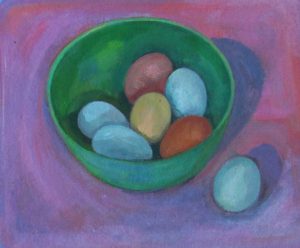
Interview with Esther Boehm
HOW DID YOUR JOURNEY AS AN ARTIST START?
I used to draw and paint as a child, my father bought me painting by numbers and although I found the images very strange with their patches of paint, I loved the process and the little pots of colour; I also loved magic painting books though I longed for them to have stronger colours. Throughout my childhood, I was enchanted by illustrations from children’s books, (especially fairy tales and Mabel Lucie Atwell drawings ) and comics.
I had a revelation when I went to see the film Snow White and saw the scene of the dwarves coming home in the upshot of the bridge; I felt it was the most amazing thing I had ever seen, not just because it was an incredible angle at which to see something, but because I knew someone had drawn and painted it. My father joined an art club and I loved the prints we were sent to hang, Caravaggio, Rembrandt, Constable. I took charge of the one frame that they were hung in and decided when to change the print. I often used to look at the print instead of the television.
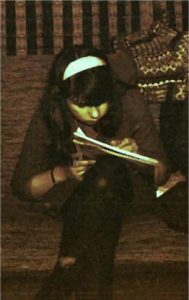
I had a wonderful teacher in Primary school who recognised my early passion for art. In secondary school, I spent a lot of time in the art room and was always given the task of decorating the classroom for Christmas or Easter etc.
In my late teens I spent time in Norfolk on holiday and marvelled at the beauty of the open landscape and the magical atmosphere in places like Saxlingham Nethergate. I painted posters of scenes from Rupert Bear for a small shop in Elm Hill, Norwich ( loved the sweet simplicity of these illustrations). though I had no idea that I could become an artist, as I didn’t even know about art college. Later, after I had left home, I talked to neighbours in Oxford who had graduated from the Ruskin who encouraged me to put together a portfolio of work and apply to the Ruskin School.
WHAT WAS IT LIKE ATTENDING THE RUSKIN SCHOOL AND THE ROYAL ACADEMY SCHOOLS? WHAT DID YOU TAKE AWAY WITH YOU?
I attended the Ruskin School of Drawing and Fine Art in Oxford (1976-79) and I absolutely loved it. I worked very hard, really enjoyed Oxford and the student life, and felt very happy to be learning so much. The Ruskin offered a highly structured course; we were taught really well how to draw and paint, and were shown many fundamental techniques and theories in drawing, painting,and printmaking which have supported my practise throughout my whole life as an artist. The Royal Academy Schools, which I attended after the Ruskin, offered another three years in a studio environment and although far less structured in the teaching, it did offer me studio space and access to tutorial support and wonderful printing facilities.
It was at the Ruskin School that Jane Greenham (Jane Dowling RA Hon.RBA) introduced us to the mediums of tempera ( pigments and a binder like egg) and distempera (pigment and size). The pigments come from a variety of sources, both organic and inorganic: metals, chemicals, earth, and stones. This medium has a lovely rich colour and a very matt quality which I love. I now work in both distempera at times and also in oil paint. Each medium has particular strengths and difficulties and I enjoy the challenge of each of them and love being able to choose the medium which I feel will work best.
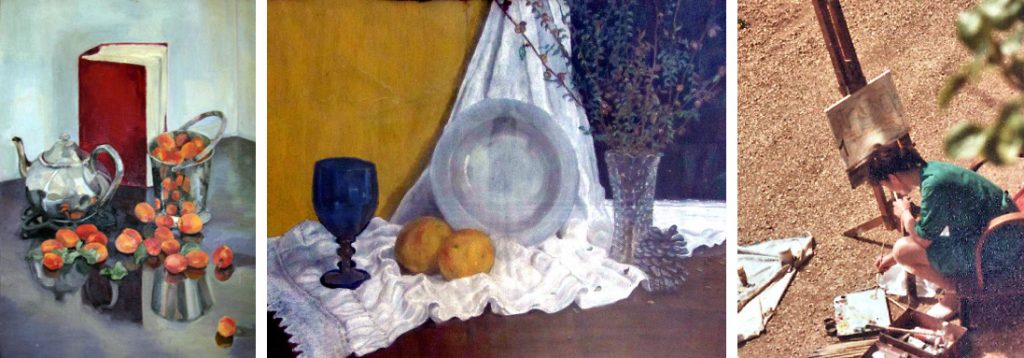
Early work during the 1970s
Distempera paintings from the Ruskin
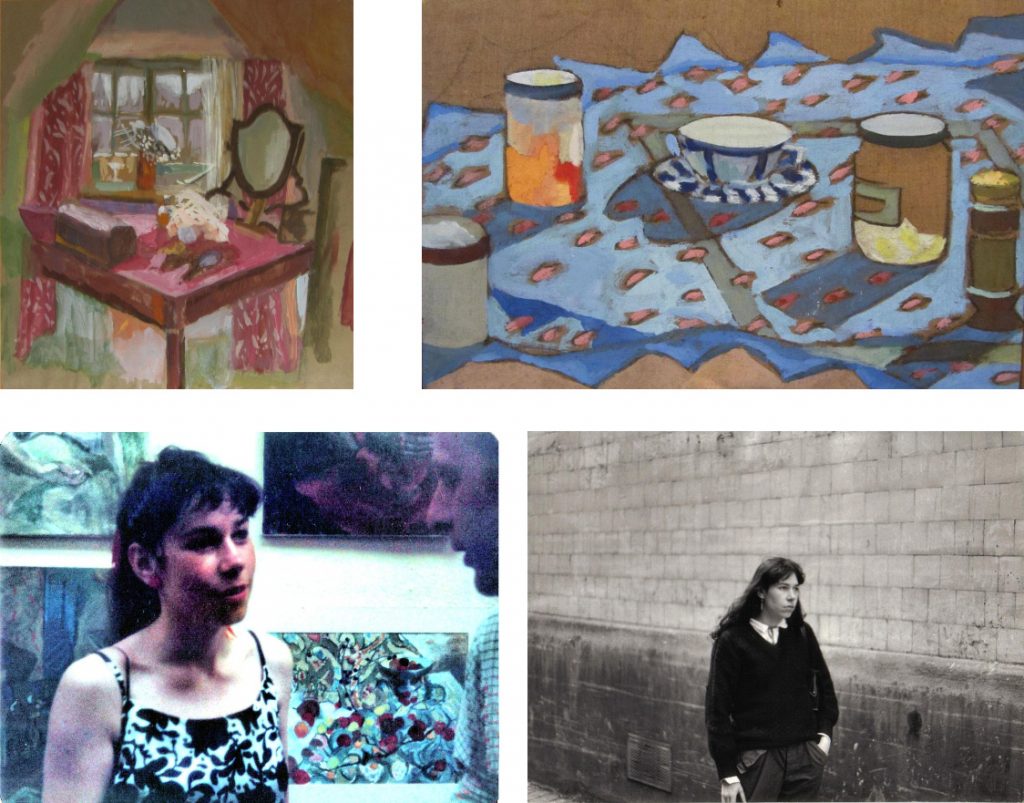
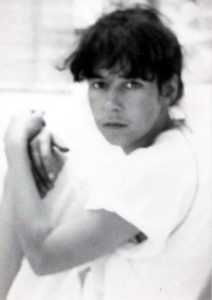
WHAT DID YOU WORK ON AFTER YOU LEFT THE ACADEMY SCHOOLS?
I left the R.A.Schools in 1982. I was lucky to be able to go back to Oxford and, through contacts and friends there, found various bits of work and somewhere to live. I was given a room, above a wonderful shop, to use as a studio, and allowed to use whatever I liked from the shop for still life material. The shop sold fabrics and pottery, and beautiful and unusual objects and toys from all over the world so I was in heaven. I had very little money but was happy to be able to paint and had found a gallery in London to show my work so was able to work towards both group and solo shows.
During this time I worked principally on portraits and fantasy still life paintings.
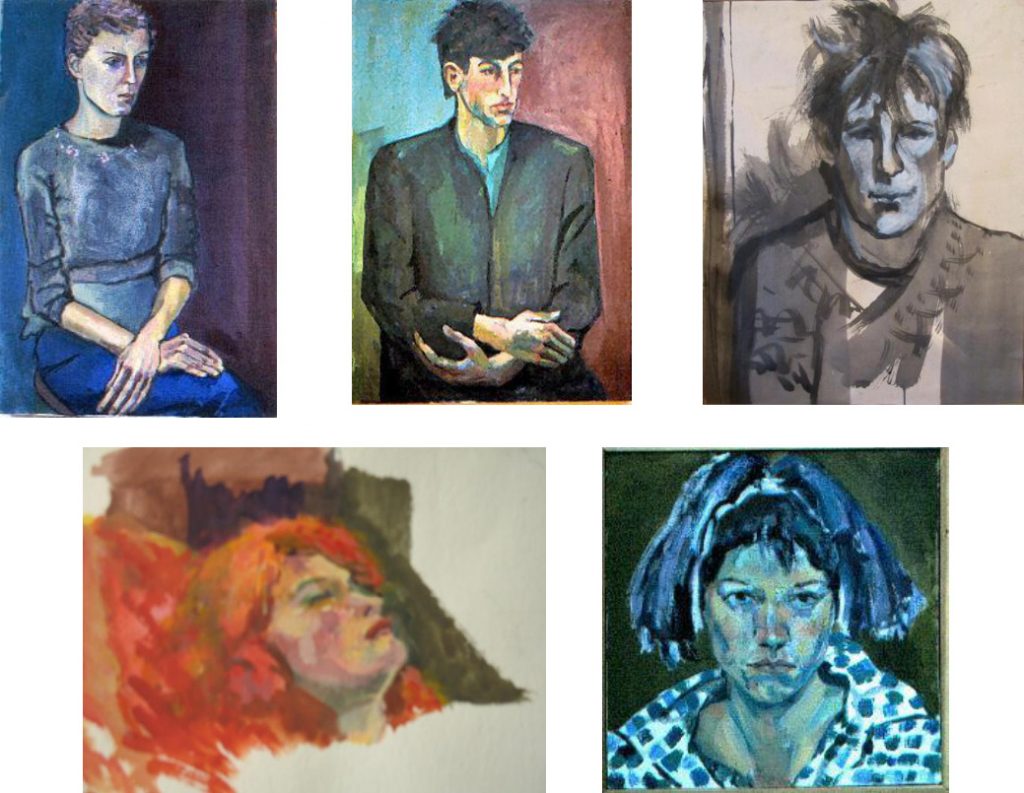
Portraits
TELL ME MORE ABOUT THESE FANTASY STILL LIFE PAINTINGS.
In these paintings I was moving away from the figurative, away from representing the objects in front of me in a traditional way, and also at times away from gravity or cast light, and in my journey to subvert the traditional interpretations of the subject matter, I stumbled, as though from the wings, on to the stage of the narrative.
The majority of images from this time have an underlying theme of collapse; collapsed distance, space, time, and object boundaries. The storytelling themes reflect this: a shipwreck, Alice through the looking glass, memories, the aftermath of a murder, pop up cards and nursery rhymes, etc. I explored the montage of memory and the nonsensical way in which a field of vision can be collapsed onto a single picture plane.
Additional paintings in this series may be viewed here.
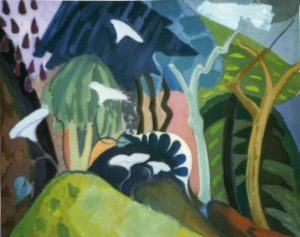
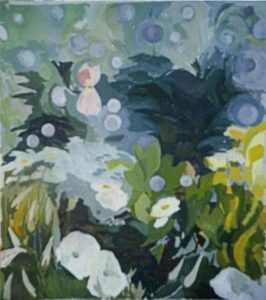
AT WHAT POINT DID YOUR PAINTING REFLECT MORE OF A MOVE BACK TO OBSERVATION AND AN INTEREST IN ORGANIC FORMS?
In the late 1980s while living in London I longed for the countryside and became more interested in flowers and nature. I began painting directly from this subject matter in gardens and parks and using cut flowers and leaves in the studio, and this interest continued when I moved to County Dublin in Ireland (1989). I had brought a significant body of work with me and having no contacts or gallery to show with, I found myself with time to experiment and play with new approaches to organic forms. I developed a body of work based on more abstract plant and fruit forms, always observed from life and informed by the colours the shapes and the tones of the organic subject matter. I worked purely in distempera on a fairly small scale (approx 12″x 15″), and, using large brushes, I worked quickly and spontaneously towards an approach of fluidity and connection to the subject matter and the medium.

Additional paintings in this series may be viewed here.
During this time my beautiful daughter Rose was born, and financial commitments meant that it was necessary to work full-time lecturing/ teaching in Art Schools and Colleges. I became a Lecturer and then Course coordinator of the prestigious Animation Course at Ballyfermot Senior College, and then took a similar position at the National Film School. Both of these posts were demanding (and rewarding) but as a consequence, the amount of time I could dedicate to my own work was lessened.

However, during the early 2000’s I worked on a series of fruit and pumpkins, painted in Distemper, which have never been exhibited but which I hope to show at some point soon. I had so little time that it became more important to simply paint than to exhibit the work, I was happy to have carved out painting time and just slotted the work into a folder under the bed so to speak.
Additional paintings in this series may be viewed here.
YOUR ROOK SERIES CAPTURES THE SUBJECTS IN A BEAUTIFUL WAY. DID YOU SPEND A LONG TIME STUDYING ROOKS TO ACHIEVE THIS?
The rook series of drawings were all made during a fairly intensive period of about 20 weeks. I had spent months before this watching and photographing the rooks because it was almost impossible to draw them from direct observation; it is so difficult to get anywhere near them, and they move so quickly, so I had to rely on the researched photographs and film material which I had collected. I was interested in understanding the anatomy and I often had to look very closely at the photographs to understand the form, sometimes taking the photographs into a paint programme on the computer to increase the contrast so that I could see the structure more clearly. I was not interested in depicting the rooks as emblems, symbols, or in a dramatised way, because the interest for me was in their natural forms and the character of the way they moved. They have a particularly beautiful angularity to them. Over the time I studied them I became increasingly aware of their awareness of each other, and their almost uncanny “one mind” responses at times. I discovered that they are highly intelligent and have a complex language, are also sociable, and they mate for life. Rooks feed each other and play together at times. I love them.
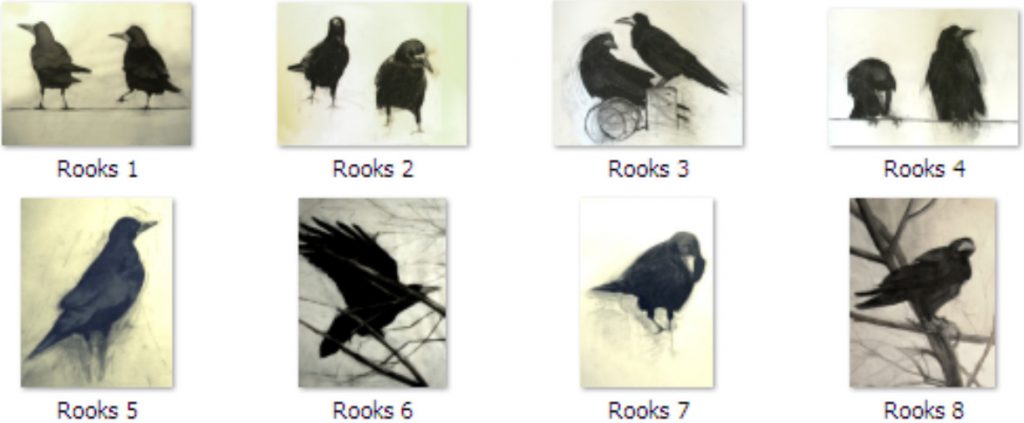
The drawings are life-size and are made with a variety of dry media and also blue/black Quink and other black inks and watercolour, they are essentially monochrome with a bit of blue/black at times. I am selling prints of the rook drawings now and the response has been very good.
Additional paintings in this series may be viewed here.
“ENCHANTMENT” IS AN APT TITLE FOR THE WORK OF YOUR PORTUGAL RESIDENCY. THE COLLECTION HAS A SPECIAL ATMOSPHERE WHAT WAS IT ABOUT THIS REGION THAT INSPIRED YOU?
In 2011 during a sabbatical year from my lecturing post at the National Film School, I discovered the lavish and exotic gardens and surrounding countryside in Sintra, and I was delighted to accept an opportunity to create a collection of paintings inspired by the gardens. I was the first artist to have been invited to create and exhibit my paintings in this wonderful World Heritage Site and I worked over a period of two years painting in different parts of the gardens at Monserrate and also in the surrounding landscape.
Portugal is a country so rich in enchantment and has many places of magnificent beauty, some of which are caught in a lavish and seductive wilderness of neglect. I saw this enchantment as a layering of realities, a resonance which has a sense of “the other”, a scintillation of significance, human time suspended or slowed, and plant time unhindered, weaving into the abandoned spaces.
Part of the nature of enchantment is in the way we happen upon it, our discovery is filled with a sense of chance, as though we are being led in, and things are being revealed to us. As a child, I lived in fairy tales, in the descriptions and illustrations of enchanted worlds of imagination and mystery. These illustrations to fairy tales so beautifully drawn and sometimes influenced by art nouveau seemed to me to be works of pure genius, and I had no idea that some of the trees plants and buildings which wove through these stories would be found here in Portugal, and particularly in Sintra. The fairy tale world of my childhood was brought to life for me there.
Catalogue Notes for the paintings and the exhibition can be viewed here.
The Portugal Blog can be viewed here.
YOU RETURNED TO THE UK IN 2016 HOW HAS THAT INFLUENCED YOUR PAINTING?
To be back in England after 26 years abroad feels so great. I am happy to be home. I wanted to settle in East Anglia, it has always felt like the right place for me to be.
I discovered a few months ago, from a long lost cousin, that my great Grandfather: William Walter Chambers, came from Bainton in Lincolnshire and was a coachman and picture framer, living just thirty miles from where I live today.
Painting landscapes from direct observation is an action-packed process because things change so quickly that there is little time to contemplate. The colours in the landscape can be difficult in many ways because there can be such a struggle to find an escape from all the yellowish greens and mid blues without necessarily ending up at dramatic sunsets for interest. There are a few things I do to help me with this: the first is to drive around and search for places which have interesting colour relationships, and the second is to use a limited palette (for instance just choosing one red one yellow and one blue and white) to force myself to interpret the colours I see, which can be very challenging but also rewarding and can give unexpected harmonies. I read somewhere that a blue sky can often kill a landscape painting, and I think it is possibly true, especially that strong mid blue you can find on a bright day. Also sometimes staying out or going out in bad weather can offer some great challenges.
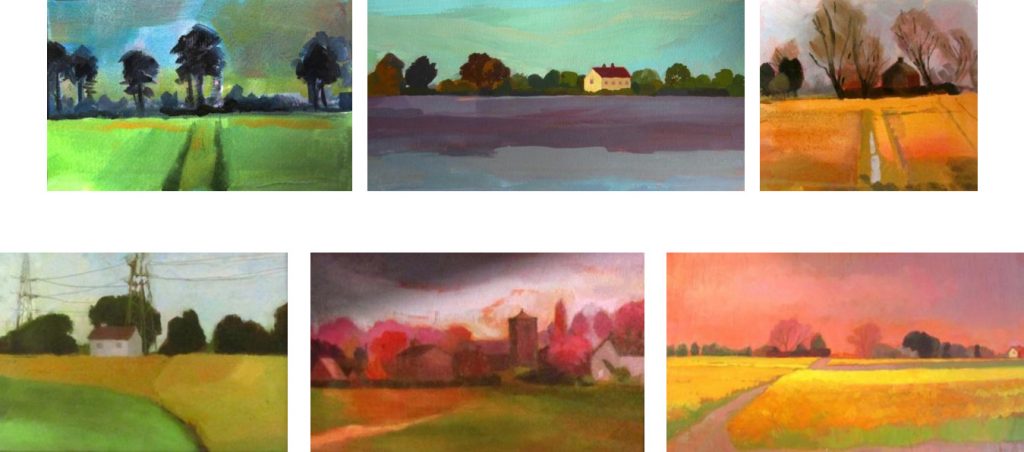
The open fields and skies and the wonderful stretches of colour found in East Anglia and in the industrial farmlands of the Fens have been a major influence on my work, and since I arrived I have painted only landscape; I have really enjoyed working outside and discovering all the beautiful and different crops and weather and light. It has been a challenge and I feel that the process has been celebratory.
Just this year I am returning to some studio and garden work and slowly re acquainting myself with the joys of flowers and fruits again.
Additional landscapes may be viewed here and here.
YOU HAVE A LONG LIST OF EXPERIENCE AS AN EDUCATOR IN THE ARTS. WHAT HAVE YOU TAUGHT?
I taught in Art Colleges in Ireland for 26 years before returning to England. I taught observational drawing, painting, animation film-making, visual language, background painting and design, concept development, and creative thinking. I developed and wrote the first animation B.A. in Ireland and worked as a consultant to the Broadcasting Commission R.T.E. to award funding to animation projects.
I was passionate about teaching throughout my career and I believed in giving my students the very best experience and education possible. I believe vocational education is hugely undervalued and underused in society as a whole and that if introduced more widely, it could prepare students for meaningful and gainful employment in a way that academic education can utterly fail to do.
Many of my former students have attained worldwide reputations and have won major prizes in the film industry. These successes include many Oscar nominations, BAFTAs and an Oscar award for Avatar. The Irish animation Industry is now seen as one of the most successful in the country and the standards of Irish animators are world renowned.
I have never believed that being able to paint and draw is a “gift”, this is simply not true.
The passion to learn and to improve and to practice art is the gift. There seems to be a belief that those who are good at art are somehow lucky. We would not say to a concert pianist that they are lucky to play well, we would know that they have dedicated time and energy and love and learning and humility to their craft, it is no different with visual art.
Today fewer and fewer people are taught to draw in school simply because their teachers have no idea how to draw themselves. Lecturers in art school may have never been taught either, and we begin to see figurative drawing disappearing, yet for many people, the skill to draw well as an artist is a deeply empowering one, and can allow someone to choose an approach in depicting a subject rather than be dictated to by a skill deficit.
I have developed a drawing course here in East Anglia which I delivered last November. It was well received and I will be running this course again at some point and also intend to develop a painting course.
To view the Facebook page for Art School for Artists, click here.
YOU USE A VERY UNIQUE PALETTE. WOULD YOU TELL US ABOUT YOUR USE OF COLOUR?
I work almost exclusively from real life observation, rather than fixed photographs or memory, this is because I find so much more information and inspiration in the process of looking. The colours I use are no different to anyone else’s but the way I perceive colour probably has the greatest influence. I am interested in the way light ( which always has a predominant colour in itself ) affects other colours, though am less interested in light falling on objects to describe their three-dimensionality. This has meant that a lot of my work has less emphasis on “modelling” and might often not appear to be “lit” from a direct source. It is important for me to focus on colour as I see it rather than on accepted ways of painting colour ( i.e. with more of a chiaroscuro technique)
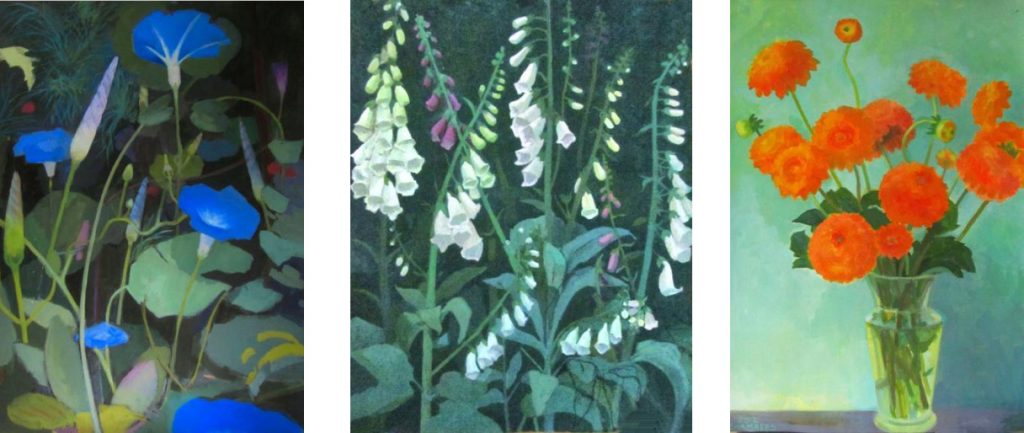
I use tone compositionally, but it is used sparingly to describe form, and darker areas are painted with particular attention to the local colour. An orange (for instance) generates orangeness, as an intensity of colour, as a taste, and as a roundness of form, and I focus on these characteristics rather than depicting the orange as an object with light falling on it. I try to be true to the living experience of seeing/feeling /remembering the orange, rather than an accepted formal depiction. These ideas seem to be clearer when using still life and flowers as subject matter rather than landscape.
I never use black at all in painting, I mix darks using complementary colours. I never use just one colour (like a burnt umber) to darken all the other colours as it can muddy and distort the overall palette. I avoid all sharp greens e.g. viridian and phalocyanine but I do use sap, oxide of chromium or chrome green and I always have some turquoise in case I find one of those magical skies. I love the interesting reds such as mars red and mars violet. Most importantly I mix my colours on the palette, not on the painting, this is so important. If you want to get your colour to work you need to put the time into the mixing with a palette knife and when you have the right colour to put it on the image with confidence which avoids all those hesitant fudges which can look so unconfident and blurry. I like to work with a limited palette sometimes because this is a wonderful way of finding new harmonies, and can be a good learning tool and a good discipline.
YOU WORK WITH A VARIETY OF MEDIA. DO YOU HAVE A FAVOURITE?
I use gouache and distempera (pure pigment and size) on paper, and oil on board. Both mediums have advantages and weaknesses. Oil can be very difficult to use if it gets too “wet” and is not always easy to work outside with, last summer in the intense heat the oils were running down the palette and I couldn’t stop them dripping everywhere; but oil has a marvellous intensity of colour, is easy to mix the exact colour needed and the great bonus is that there is no need to protect when dry so no glass needed between the paint and the viewer.
I love using pigment, and love the way it dries so quickly and the way it handles, but the finished painting is vulnerable so needs framing and glazing which is a great shame because when the paint is just raw on the paper/board without glass, the matt velvety texture and the quality of the colour is direct and soft and glowing which is beautiful.
WHAT IS IT YOUR PHILOSOPHY AS AN ARTIST?
This is a question which is easier to answer in retrospect. It is something which is evolving and changing. I am interested in the writings of the poet Gerard Manly Hopkins and his religious and metaphysical convictions which discuss “isness” and instress”
“Hopkins felt that everything in the universe was characterized by what he called inscape, the distinctive design that constitutes individual identity. This identity is not static but dynamic. Each being in the universe ‘selves,’ that is, enacts its identity. And the human being, the most highly selved, the most individually distinctive being in the universe, recognizes the inscape of other beings in an act that Hopkins calls instress, the apprehension of an object in an intense thrust of energy toward it that enables one to realize specific distinctiveness.”
Quote from Stephen Greenblatt
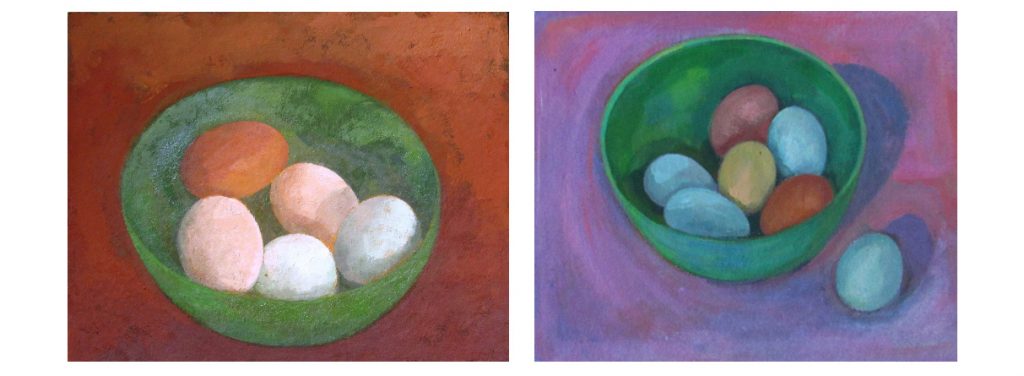
I believe that we are each drawn to different and specific colours, scents, forms, materials, music, lights, moods, and people and that these “attractions” are formed because at a metaphysical and at a physical level we “recognise” or “connect with” particular energetic frequencies which resonate with our own, and that when we experience this harmonic it will engender a feeling of belonging, of recognition, of pleasure and of significance. I believe that all works of art can generate and emit energies which resonate and harmonise and which can literally be a positive force in their environment.
I believe it is terribly important to remember that painting is a process, not a production, and that the energy and intention which goes into the creation of a painting is most important. A painting is a by-product of a mediation and interaction with the world and with the shapes and colours of the subject matter. If this process is not nourishing and bringing real excitement and joy as well as a challenge and a struggle, then why do it? The process of making work can be really deeply rewarding and worthwhile and I believe that this actually shows in the work too.
Imagine a piece of music played perfectly by 10 people, but only one or two players might move us because their soul and spirit are in the playing and we can actually hear and feel this. It’s really not so different with visual art.
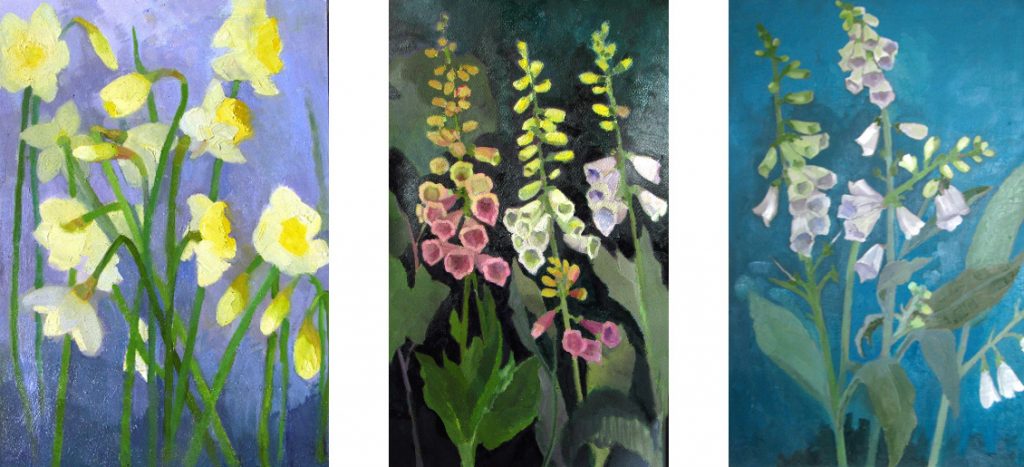
SO WHAT COMES NEXT?
I am working on a series of still life paintings and flowers this summer. Right now about to begin some paintings of hollyhocks which I planted 2 years ago. White foxgloves are nearly over and the fabulous green seed pods of the opium poppies beckon.
I am also preparing for my second Christmas in Vermont with my daughter and where I will be continuing to make studies of that stunning, and at times bleak, icy landscape. I have wanted to paint snow for years and finally I have a chance to do that. It’s a whole new set of challenges and I am only just beginning, so it’s very exciting.
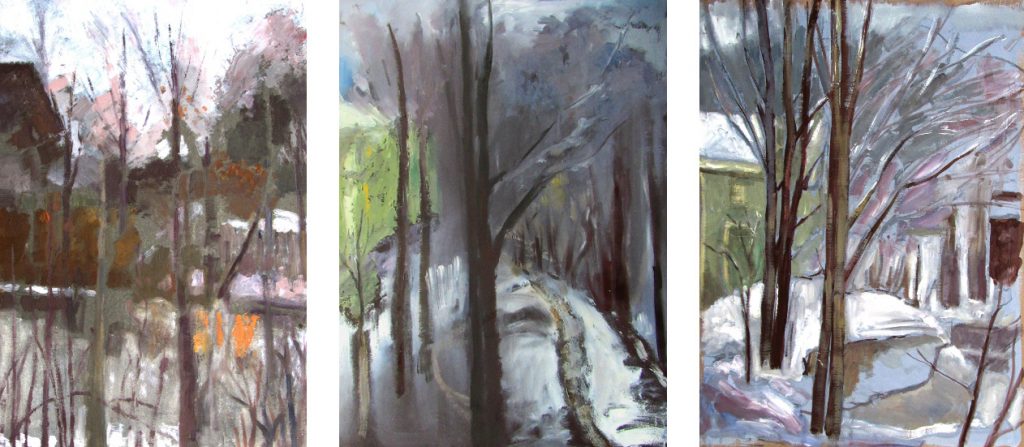
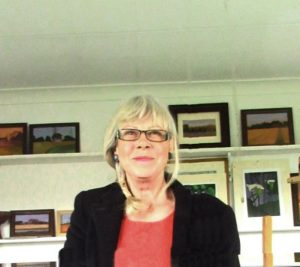
Additional Links
Email: tamtambird@gmail.com
Official Website
Official Blog
All photos copyright Thelma Chambers.
